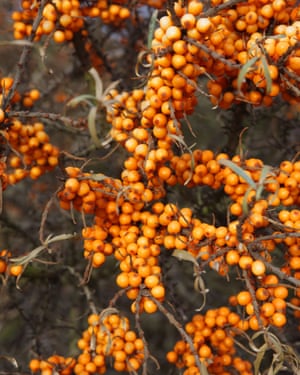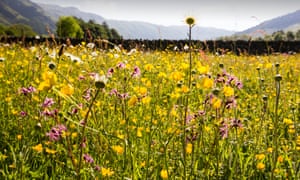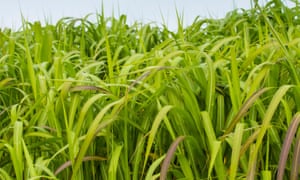Source: theguardian.com
Climate change and poor returns on wheat and dairy drive rural revolution in ‘future-proof’ agriculture
A field of miscanthus, or elephant grass – the crop is used by the energy industry. Photograph: Alamy
Farmer Rob Pickering last week planted nine hectares of flood-prone land in Lincolnshire with an African plant called miscanthus, or elephant grass. By selling the fast-growing crop as biofuel for Drax power station, he should earn as much as he would from selling wheat on the world market.
Pickering is part of a rural revolution that, thanks to climate change, low commodity prices and new consumer tastes, is seeing Britain’s fields planted with crops that are more likely to end up as electricity or paint additives than food.
In Essex, David Eagle is growing acres of sea buckthorn, a salt-tolerant plant that grows wild in Siberiacorrect and northern Europe. Its orange berries can be used in food and drink products, but are bought mainly by cosmetics and pharmaceutical industries. Eagle knows his coastal defences may not withstand many more storms and increases in sea-levels, so wanted a future-proof crop. “Our sea walls are in good condition but the future may not be so certain in an era of climate change,” he says.
In East Anglia, borage, hemp and flax are being grown for their oils, daffodils for drugs use, and lavender for cosmetics. The hop fields of Kent are expanding as the global boom in micro-breweries sees British hop exports to the US soaring, and wildflower seed farms are springing up on former grazing land in Lincolnshire as farmers take environmental action in return for EU subsidies.
Dorset farmers are paid premium prices by drugs firms to grow poppies and cannabis for medicines, but the market for pharmaceuticals is small, tightly controlled and limited, says David Turley of the National Non-Food Crop Centre(NNFCC) in York.
“Non-food crops have seen boom and bust years as farmers try planting new crops in bad times, only for the price to drop when supply outstrips demand,” he says. “Three years ago, everyone was growing evening primrose. Then the Chinese got in and that ended.”
Warmer winters have allowed exotic fruits and vegetables to be grown commercially in Britain, says the National Union of Farmers, but industrialists expect the next boom to be in plants whose sugars can be used to make plastics and packaging .
“There is great interest in the bio-economy,” said Turley. “We are now taking ethanol [from wheat] to make plastics. It’s an emerging market that I think will become huge as large brands become concerned about sustainability. I would expect many more plants to be grown for plastics.”

Sea buckthorn is being grown by coastal farmers as it is a salt-tolerant plant. Photograph: Alamy
Planting for niche industrial uses is becoming more common, but so far only 100 or so hectares are planted commercially with crops such as high-erucic acid rapeseed, Buglossoides arvensis and camelina (false flax). These are now grown for use in petroleum additives, polymers and skincare products.
Staffordshire firm Statfold Seed Oils estimates the total world market for hemp oil is only about 200 tonnes, and it supplies nearly 150 tonnes of that. “Many farmers have latched on to the high prices, but we are dealing with pretty small volumes,” said a spokesman.
According to Boston Seeds in Lincolnshire, there is significant and growing demand for wild seeds, both from farmers obliged to plant field margins with bird-friendly plants to receive their EU grants, and from home gardeners.
Many older dairy and arable farmers were turning to energy crops because they required less physical work and offered security when cereal or milk prices fell, said George Robinson of agricultural energy firm Terravesta. It has contracted 350 British farmers to grow 5,000 hectares of miscanthus as a biomass source for power stations. “The British landscape that was once mixed farming is no longer,” he said. “Dairy farmers are going. Grassland is being converted. We’re adding 1,000 hectares of miscanthus a year.”
About 350,000 hectares in Britain are suitable to grow it and Robinson is confident that he can persuade thousands more farmers to plant the grass. “This is just the start,” he says.

There is a growing demand for wildflower seeds – EU farmers need to tick environmental boxes to get grants. Photograph: Ashley Cooper / Barcroft Media
The amount of land planted with energy biomass crops, such as miscanthus, willow and poplar, grew by nearly 50% in 2014-15 and is now more than 120,000 hectares, or 3%, of arable land. If Britain is to meet its target of 15% of energy from renewable resources by 2020, much more will be needed.
Crops producing biofuels for petrol and diesel additives are also popular: thousands of hectares of wheat are expected to be planted this year to supply theVivergo Fuels bioethanol factory in Hull. It uses a million tonnes of wheat to provide 420 million litres of renewable fuel a year – about half the UK’s target.
Other farmers and estates have turned their acres from pasture to more traditional cash crops, like Christmas trees.
“The trade is changing,” says Harry Brightwell, secretary of the British Christmas Tree Growers’ Association, who estimates there are now 5-7,000ha grown. “There’s all kind of people growing them now. Some are farmers diversifying into trees, but there are estates with over 1m trees in Scotland. It’s an industrial crop now. But we still can’t get enough good trees.”

A lavender field in west Sussex. Photograph: David McHugh/REX/Shutterstock

No comments:
Post a Comment